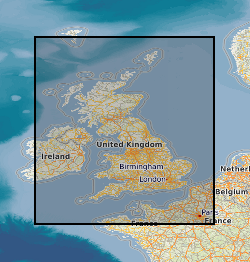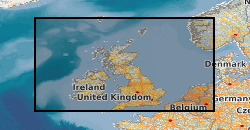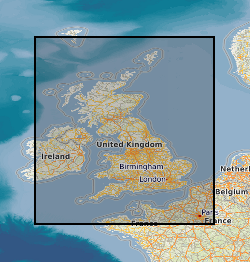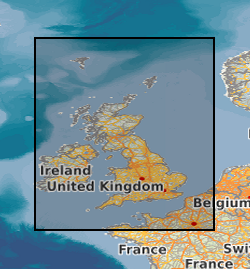Continental shelf
Type of resources
Available actions
Topics
Keywords
Contact for the resource
Provided by
Years
Formats
Representation types
Update frequencies
Scale
-

The Bedrock summary lithologies dataset is digital geological map across the bulk of the UK Continental Shelf (UKCS), for areas up to a water depth of 200 m, which groups the bedrock lithologies (rock types) into classes based on similar engineering geology characteristics. The map is derived from the 1:250 000 scale digital bedrock map of the UKCS (BGS Offshore Bedrock 250k), which is available separately from BGS. The map was produced in 2014 in collaboration with, and co-funded by, The Crown Estate as part of a wider commissioned project to assess seabed geological constraints on engineering infrastructure across the UKCS. The divisions on the map combine the bedrock formations into 8 classes (with several subdivisions) of similar strength and lithological variability, each with a 'Category' title that summarises their main lithological character: Class1 – Igneous; Class 2 - Tertiary Sandstone and Limestone; Class 2.5 - Tertiary Sandstone and Limestone Interbedded; Class 3 - Tertiary Mudstone; Class 4 - Mesozoic Sandstone and Limestone; Class 4.5 - Mesozoic Sandstone and Limestone Interbedded; Class 5 - Mesozoic Mudstone; Class 6 – Chalk; Class 7 – Metamorphic; Class 8 - Palaeozoic Sedimentary. The data are held by the BGS as an ESRI Shapefile.
-

Added value microfossil analyses carried out on material from the British Continental shelf are included. Sample number, borehole details, locality and geological information are given together with microfossil identification. The identification logging sheets are housed in box files. Symbols included: CSA1-2205 Continental Shelf Unit North; CSB1-6047 Continental Shelf Unit South; CSC1-7134 Offshore microfossils; CSD1-507 Offshore microfossils; CSE1-6826 Offshore microfossils (incidental and occasional macrofossil data are included). The raw data is held in CONTSHELFRAW and the interpretative reports relating to the microfossils are held elsewhere (TECHREPORTS).
-

The Quaternary deposits summary lithologies dataset is a digital geological map across the bulk of the UK Continental Shelf (UKCS), for areas up to a water depth of 200 m, which groups the deposits into classes based on similar engineering geology characteristics. The map is derived from (unpublished) BGS 1:1,000,000 scale Quaternary digital geological mapping, so is effective at that scale. The map was produced in 2014 in collaboration with, and co-funded by, The Crown Estate as part of a wider commissioned project to assess seabed geological constraints on engineering infrastructure across the UKCS. The divisions on the map combine the Quaternary deposits into 7 categories of similar strength and lithological variability, each with a ‘Category’ title that summarises their main lithological character: diamict; firm to hard interbedded (layered); firm to hard mud; sand and gravel; soft interbedded; soft mud; undifferentiated. These categories can be used as a basis for assessing, in conjunction with a range of other geological factors, the geological constraints on engineering structures at or close to the seabed. The data are held by the BGS as an ESRI ArcGIS Shapefile.
-

The Quaternary deposits thickness dataset is a digital geological map across the bulk of the UK Continental Shelf (UKCS), for areas up to a water depth of 200m, which shows the thickness of the deposits over bedrock in three categories: <5 m, 5 - 50 m, and >50 m Quaternary cover. These depth bands were picked because they represent the horizons that have impact on offshore infrastructure deployment. The map is derived from (unpublished) BGS 1:1000000 scale Quaternary digital geological mapping. The map was produced in 2014 in collaboration with, and co-funded by, The Crown Estate as part of a wider commissioned project to assess seabed geological constraints on engineering infrastructure across the UKCS. The data are held by the BGS as an ESRI Shapefile.
-

The BGS Predictive Seabed Sediments UK v1 dataset includes digital maps of seabed sediment (SBS) composition across the UK Continental Shelf (UKCS). The dataset includes one classified SBS map (Folk sediment class; vector), and three percentage-sediment maps (rasters) giving the proportions of gravel, sand, and mud. The dataset is generated using a machine learning algorithm known as a Distributional Random Forest (DRF). The model uses input data to predictively classify what seabed sediments are most likely to be the dominant sediment present. It does so, using more than 38,000 seabed sediment samples (collated from various sources) with measurements of the proportion of mud, sand and gravel from locations across the study area. The predictions are constrained against covariate variables that are known to influence which sediment is most likely to occur. These include bathymetry data morphometric derivatives (at multiple spatial scales), as well as hydrodynamic data layers (currents and tidal). The dataset was reviewed via a qualitative assessment (QA) protocol by subject-area experts (e.g. contrasting with previous mapping, and local examples of higher-resolution data and mapping), and following methodological improvements based on this feedback, updated SBS map products were prepared. The dataset is presented at a national-scale, with a spatial resolution of approximately 110m, covering the UKCS (slightly modified UKCS area based on data availability).
-

The BGS Offshore Bedrock 250k dataset contains vector data which reflects the offshore bedrock geological of the UK and some of its adjacent waters (the UK Exclusive Economic Zone, EEZ) at 1:250,000 scale. This comprehensive product provides a digital compilation of the paper maps published by BGS at the same scale, as well as, additional re-interpretations from regional geological studies. The composition, age and deformational history of the rocks underlying the seabed (bedrock) are important for a range of stakeholders, including marine spatial planners and offshore developers. The dataset is arranged in two GIS layers: Bedrock Lithostratigraphy and Bedrock Structural Geology. The polygons within the Bedrock Lithostratigraphy layer show the spatial distribution of the principal lithostratigraphical units (formations and groups). The lines within the Structural Geology layer show the location and extent of known structural features such as faults and folds. This dataset was compiled from remotely sensed geophysical data (e.g. airgun, boomer, sparker, sidescan sonar, magnetometer, gravity meter) and ground-truthing data obtained from commercial wells and BGS shallow boreholes. The variations in data density are reflected in the detail of the mapping. The bedrock divisions on the map represent the principal lithostratigraphical units (e.g. formations and groups) in the UK, ranging in age from Proterozoic to Cenozoic, as defined in the BGS Lexicon of Named Rock Units. An additional layer delineating the principal structural features, such as faults and folds observed at the rockhead is also included. This dataset was produced for use at 1:250 000 scale. The data should not be relied on for local or site-specific geology.
-

The BGS Seabed Sediments 250k dataset is vector data which reflects the distribution of seabed substrate types of the UK and some of its adjacent waters (the UK Exclusive Economic Zone, EEZ) at 1:250,000 scale. This comprehensive dataset provides a digital compilation of the paper maps published by BGS at the same scale, as well as additional re-interpretations from regional geological studies. The seabed is commonly covered by sediments that form a veneer or thicker superficial layer of unconsolidated material above the bedrock. These sediments are classified based on their grain size, which reflects the environment in which they were deposited. This information is important to a range of stakeholders, including marine habitat mappers, marine spatial planners and offshore industries (in particular, the dredging and aggregate industries). This dataset was primarily based on seabed grab samples of the top 0.1 m, combined with cores, dredge samples and sidescan sonar acquired during mapping surveys since the early 1970s. Variations in data density are reflected in the detail of the mapping. The sediment divisions on the map are primarily based on particle size analysis (PSA) of both surface sediment samples and the uppermost sediments taken from shallow cores. Sediments are classified according to the modified Folk triangle classification (Folk, 1954, Journal of Geology, Vol. 62, pp 344–359). The modified Folk diagram and classification used by BGS differs from that created by Folk (1954) in that the boundary between 'no gravel' and 'slightly gravelly' is changed from trace (0.05%) to 1% weight of particles coarser than -1Ø (2mm), shown below. The boundaries between sediment classifications or types are delineated using sample station particle size analyses and descriptions, seafloor topography derived from shallow geophysical and, where available, multibeam bathymetry, backscatter and side-scan sonar profiles. This dataset was produced for use at 1:250 000 scale. These data should not be relied on for local or site-specific geology.
 NERC Data Catalogue Service
NERC Data Catalogue Service